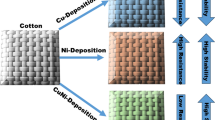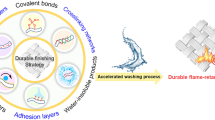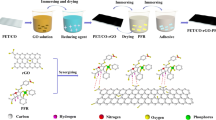Abstract
Electrical conductive and flexible flame-sprayed Al coatings using powder and wire as raw material were successfully deposited onto diverse textile fabrics. The influences of the raw materials, spraying parameters, and fabric materials on the electrical conductivity and microstructure of the metal-fabric composites were investigated. A first series of experiments showed that a coating quantity higher than 20 mg/cm2 is necessary for a very good surface conductivity. After the optimization of the spraying parameters, such as a reduced standoff distance and the use of a cooling setup, a high surface conductivity (∼500 S A) was obtained, which is attributed to a better melting of the spray particles. The improvement in conductivity enables a reduction of the coating quantity, and therefore, the flexibility of the fabric materials is better conserved. This study showed that optimized electrically conductive composites onto flexible fabrics can be produced, without any preliminary thermal or chemical fabric specifications.
Similar content being viewed by others
Explore related subjects
Discover the latest articles, news and stories from top researchers in related subjects.Avoid common mistakes on your manuscript.
Introduction
Electrical conductive flexible fabric materials represent a new approach for the production of different integrated applications, for example, wearable electronics, lighting, or communication in medicine techniques (Ref 1-3).
Up to now chemical processes are used to produce composites from copper and fabric materials, but these techniques are expensive and potentially dangerous for the environment. Physical coating processes, for example, CVD, overheat the substrate and produce only very thin coatings, which are barely conductive when applied onto fabric materials. Therefore, thin metallic sheets are mostly used for such applications, but the sheets are liable to crease and tear.
Nowadays, no process exists for aluminum-fabric material composites, which would possess the high electrical conductivity needed for advanced applications, for example, as an electrode holder in Lithium-ions battery.
In the present study, an Al-coating flame spray procedure was evaluated. It is a cost-effective, quick, and versatile process that could be easily upscaled for mass production (Ref 4). Two different flame spray guns were investigated: one using Al wires as feeding material, the other with powder feeding.
For the wire flame spray process, a wire is injected axially into the flame, where its tip melts and the formed droplets accelerate to high velocities by the flame gases. For the powder flame process, Al powder is injected into the flame using a powder feeder. The melting and the transport of the molten droplets are similar to wire flame spraying. For both flame spray processes, the droplets impact the substrate, where they are deformed due to their high kinetic energy. The droplets cool down, and the coating is formed by the superposition of deformed droplets, which are named “splats” (Ref 4, 5).
The flame spraying of metallic materials onto textile fabric, which is an extremely heat-sensitive material, represents a significant challenge due to the high particle temperatures encountered during the impact of the droplets onto the fabric material. To protect the fabric material during the flame spraying process, an adequate cooling system of the substrate is necessary (Ref 6, 7).
Materials, Coatings, and Experimental Procedure
A Metco 5P-2 powder flame spray gun and a GTV 12E wire gun were used. Aluminum powder with a particle size distribution of −90 + 45 μm and an aluminum wire with a diameter of 3.2 mm were selected. Figure 1 shows the morphology of the powder and the tip of the wire. The powder particles are not perfectly spherical but do not exhibit too sharp edges; no particles are bigger than 100 μm. Therefore, their flowability in the powder feeder and into the flame was assessed to be reasonable and feeding occurs without any pulses.
For the substrate, 3 different polyester fabrics were studied, labeled 5248, 5911, and “XX.” The major difference between the first two fabrics is their density (fibers/cm2); the fabric 5911 has a more loose structure combined with two significantly different rough sides (Fig. 2). The fabric “XX” exhibits more open meshes combined with a uniform side structure.
Table 1 lists the different spray parameters used for the production of the metallic coatings onto the fabric substrates. As a first step in the spraying optimization, only the standoff distance and the substrate cooling were varied for different amounts of deposited material.
For the first experiment series without any substrate cooling, the standard standoff distance (SP) for powder and wire spraying (SW) was chosen. In the second part of the study, with the use of an adequate substrate cooling system, the spray distance could be reduced up to 250 mm (SP-250) for the powder flame spray process and up to 300 mm (SW-300) for the wire process, without inducing any burns or thermal damages on the fabrics.
To produce the coatings onto A4-sized fabrics, the powder or wire flame spray gun was moved following a meander movement parallel to the textile surface. Several layers were necessary to obtain complete coverage of the fabric surface and uniform coating. The required number of layers is dependent on the raw material (powder or wire) and on the spray parameters.
The coating quantity (mg Al/cm2 fabric) of the sprayed samples was determined by weighing the fabric samples before and after the spraying process.
The surface conductivity of the sprayed samples was evaluated using a 4-point measurement method with a Keithley 2010 multimeter. Figure 3 shows the setup of the sample holder for the measurement of the surface resistance. First, the samples were cut in stripes with a width of x = 2 cm, and the electrical resistance R y was measured on these stripes at different distances (y = 2, 4, 6, and 8 cm). The specific surface electrical resistance R A (where the index A stands for “specific surface”) is obtained by the quotient of the measured electrical resistance R y and the corresponding measurement distance (y), multiplied by the stripe width (x). The reciprocal value of the surface electrical resistance is the surface conductivity S A. The reported values are the average of the measurements performed at the 4 different distances.
The surface and the microstructure of the coatings as well as the interface between the coatings and the fabrics were investigated using scanning electronic microscopy (SEM). For the investigations of the interfaces, the samples were imbedded and cross sections were prepared using standard metallographic procedures.
Results and Discussion
For the first series of experiments no substrate cooling was used. For several fabric types and raw materials, a minimum coating quantity of 20 mg/cm2 was evaluated in order to obtain a conductive surface. Therefore, for the following optimization experiments, the target value for the coating quantity was set to 20-25 mg/cm2. Table 2 gives an overview of the properties of the samples of these series of experiments.
The use of the fabric 5248, which has a tightly woven structure, enables a higher surface conductivity than the fabric 5911, which has a more 3-dimensional and looser structure. This can be explained by a better interconnection between the individual sprayed splats. Figures 4 and 5 show the surface morphology of the samples P1 and W1 (fabric 5248). Obviously, their microstructures consist of individual particles with a high number of not fully molten particles.
The limited contacts and interconnections between the individual splats lead to a relatively low absolute surface conductivity of the samples. Cross sections of the samples have shown (see for instance Fig. 8 and 12) that there is only a very low penetration of aluminum in the fabric thickness. The higher surface conductivity of the samples sprayed using a wire as raw material is believed to be due to the fact that the particles are more uniformly molten (Fig. 5 in comparison with Fig. 4).
Through the use of two air amplifiers for the cooling of the fabric surface during the spraying process, the standoff distance could be further minimized. As shown in Table 3, the reduction of the standoff distance due to the use of an adequate cooling system has a significant influence on the electrical conductivity as well as on the microstructure of the aluminum coatings, the latter being shown in Fig. 6-8. For an easy comparison, the properties of samples P2 and W2 are also listed in Table 3. Evidently, the standoff distance (SP and SW) could be significantly reduced by using an adequate cooling system, resulting in an increase of the surface electrical conductivity without inducing any damage on the fabrics.
For the powder-sprayed samples with comparable coating quantities, there is an increase of the surface conductivity when the spray distance is reduced. This is assumed to be due to a more uniform and better molten state of the particles on impact with the fabric surface when the standoff distance is shorter.
For the wire-sprayed samples, the influence of the spray distance on the conductivity is more significant than for the powder-sprayed samples. Furthermore, to obtain the same coating quantity as for powder-sprayed samples, fewer layers are necessary and the resulting conductivity is almost doubled. The optimal standoff distance for wire-sprayed samples is SW-300 mm, since for shorter distance (SW-350), the electrical conductivity is significantly reduced combined with the fact that the fabrics were burned and damaged. With comparable coating quantity, the wire-sprayed samples are quite stiffer than the powder-sprayed samples, which can be explained by the more uniform morphology of the coatings.
Figures 6 and 7 show the surfaces of the samples (PC3 and WC2) whose cross sections are shown in Fig. 8. Although the surface morphology displays individual particles, the cross sections make clear that these particles are well molten and form a more or less dense structure. By using the wire process, an excellent and uniform aluminum distribution (Fig. 7) along with conductivity values up to 500 S A could be obtained. Thus, in the next steps, the goal was to decrease the quantity of deposited aluminum.
The cross section of the double-sided sample PC3 (Fig. 8 left-hand side) shows that the coating microstructure is independent of the fabric side used. However, in the fabric center, some cavities are present and contacts between the two Al coatings may be observed only at few locations. The rougher structure of the fabric backside is similarly coated as the smoother front side. The cross section of the sample WC2, in Fig. 8 (right-hand side), shows that with the use of the wire spray process the coating buildup is considerably more flat and uniform combined with a very good interconnected structure.
Figures 9 and 10 illustrate the influence of the fabric structure with optimal spray parameters. It can be assumed that for a fixed coating quantity, higher conductivity values may be obtained with smooth fabric sides than with rough fabric sides.
This influence of the roughness is only significant for the wire-sprayed samples. It is also worth noting that the scattering of the values for the wire-sprayed samples is quite low, which is another sign that the particles are better molten, and therefore, on one hand, the contact between them is significantly better and, on the other hand, they conform themselves more easily with the substrate topography. It may be observed in Fig. 10 that a more open fabric structure induces higher surface electrical conductivity values, due to the metallic contact between each coated sides of the fabric material. This results in a substantially thinner and lighter composite. However, such structures are less flexible than comparably conductive composites produced from denser fabric structures. Figures 11 and 12 show the surface and the cross section of such an open-mesh sample, produced with the fabric “XX.”
Conclusions
Electrically conductive powder and wire flame-sprayed aluminum coatings were successfully deposited onto different polyester textile materials. Wire-sprayed coating results in better coating morphology. With the optimal spray parameters, electrical surface conductivities up to 500 S A were obtained. The coating quantities necessary to obtain a good surface conductivity are strongly influenced by the fabric texture; typical quantities are around 20 mg/cm2 for one-sided coated samples. This value can be decreased below 15 mg/cm2 when double-sided coated specific fabric materials are produced. This material quantity corresponds to an optimal coating thickness ranging between 75 and 100 μm. For thicknesses lower than this range, the surface electrical conductivity is extremely low and for thicknesses higher than this range, the flexibility of the textile fabric is lost.
An essential requirement is the use of an adequate cooling system of the substrate (air amplifiers), which enables a significant reduction of the standoff distance. The better melting characteristic of the particles due to this shorter distance produces a more homogeneous coating structure combined with the retention of the flexibility of the fabric material.
On the basis of the very promising test results, Al-Polyester composites for current collectors were produced. It could be shown that application specific electrically conductive composites with adjustable specific surfaces and microstructures can be produced on flexible fabric substrates without inducing any thermal or chemical damages on the fabric material.
References
D.W. Carroll, Wearable Personal Computer System Having Flexible Battery Forming Casing of the System, US Patent 5572401, 1996
Z.S. Nakad, “Architectures for e-Textiles,” PhD Thesis, Virginia Polytechnic Institute and State University, Blacksburg, Virginia, USA, 2003
R.F. Service, Patterning Electronics on the Cheap, Science, 278(5337), 1997, p 383-384
E. Lugscheider, Handbuch der thermischen Spritztechnik (Thermal Spray Handbook), DVS-Verlag GmbH, 2002, 221 pp
P. Fauchais, A. Vardelle, B. Dussoubs, Quo Vadis Thermal Spraying, J. Thermal Spray Technol., 2001, 10(1), p 44-66
K.V. Niessen and R. Gadow, Thermally Sprayed Ceramic Coatings on Flexible Fiber Woven Fabrics, International Thermal Spray Conference 2002, E. Lugscheider and C.C. Bernd, Ed., DVS Deutscher Verband für Schweißen, Essen, Germany, March 4-6 2002, p 220-224
R. Gadow and K.V. Niessen, Continuous Coating of Technical Textiles from “Coil to Coil”, International Thermal Spray Conference 2005, E. Lugscheider, Ed., DVS Deutscher Verband für Schweißen, Basel, Switzerland, May 2-4 2005, p 454-459
Acknowledgment
The authors would like to thank the Austrian National Foundation for funding this research work in the frame of the project Austrian Light Weight Structures.
Author information
Authors and Affiliations
Corresponding author
Rights and permissions
About this article
Cite this article
Voyer, J., Schulz, P. & Schreiber, M. Conducting Flame-Sprayed Al Coatings on Textile Fabrics. J Therm Spray Tech 17, 583–588 (2008). https://doi.org/10.1007/s11666-008-9213-1
Received:
Revised:
Accepted:
Published:
Issue Date:
DOI: https://doi.org/10.1007/s11666-008-9213-1
















